Printed pattern guide
Vicki Husband
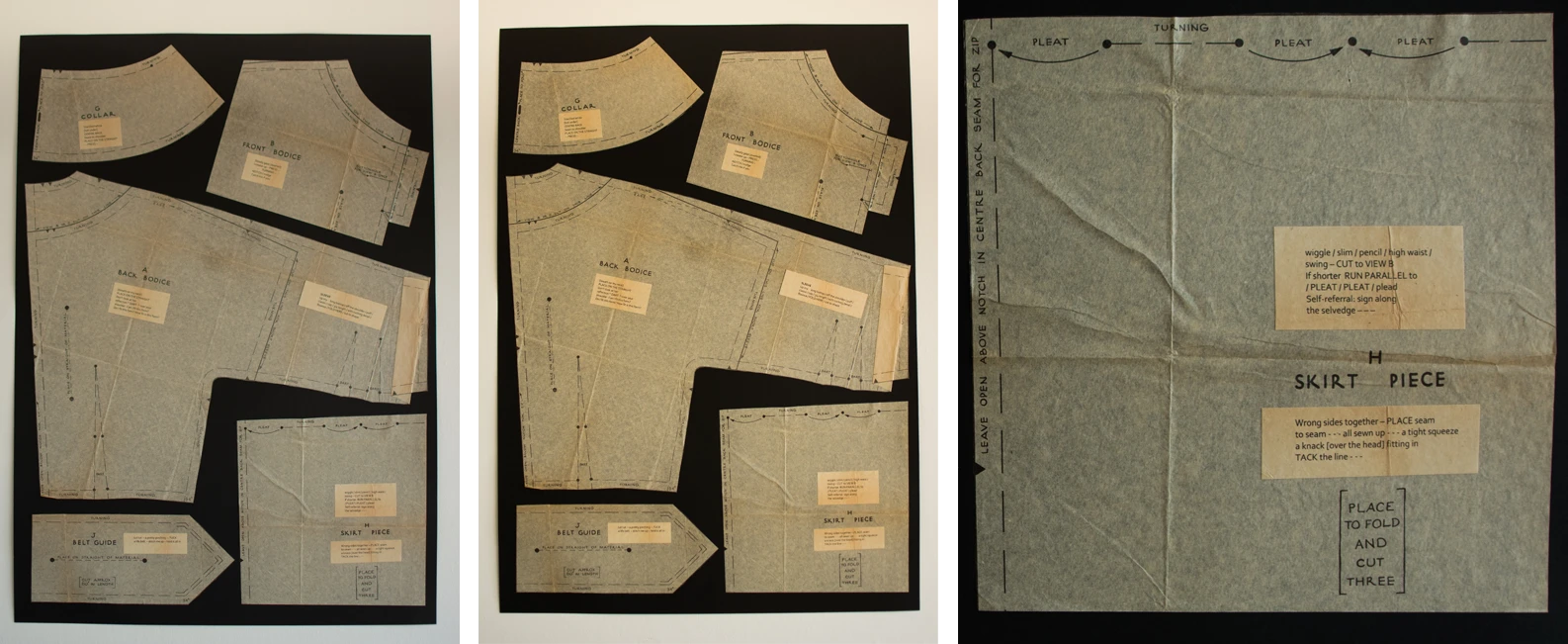
Printed pattern guide
Collar
Starched white[hot under]
CENTRE BACK
Seam to shoulder
PLACE ON THE STRAIGHT
– PRESS –
Front bodice
Steady gaze [averted]
I crease up – PRESS –
– TURNING –
NOTCH / nudge
Catch me if you
Back bodice[breath on my neck]
PLACE ON THE STRAIGHT
Don’t look at her
reflection ^ DART ^ over your
shoulder Can I fit this form?
Do I fit this form? How fit is this form?
Sleeve
Up my long bishop / off the shoulder / puff /
classic / cap / 3/4 length / with ruching detail /
flounce / FOLD HERE / cut to shape
Skirt piece front
wiggle / slim / pencil / high waist /
swing – CUT to VIEW B
If shorter RUN PARALLEL to
/ PLEAT / PLEAT / plead
Self-referral: sign along
the selvedge – – –
Skirt piece back
Wrong sides together – PLACE seam
to seam – – – all sewn up – – – a tight squeeze
a knack [over the head] fitting in
TACK the line – – –
Belt
tut tut – a pretty pinching – TUCK
a life belt – stitch me up – hold it all in

Version 1
I make you sick
You make me sick
– touché
So you prescribe
an emetic
to purge any
unwanted thoughts
I may have,
to avert my longing
I am violently at sea
Every woman a wave
I can’t look
at the female form
for three months
can’t pass a mirror for fear
of meeting
my own eye
Then the effects
subside
I sense a high tide mark
at certain times, but
remain unchanged
I raise my gaze
Define
deviation
Version 2
They say: anticipation is worse than
I am waiting to receive an image upside down
from ganglion cells via (don’t shoot the messenger)
optic nerves to deviant cerebral cortex
traitorous brainstem
They say: anticipation is
the flinch before
a piloerection response
a wave of resistance
knows me better than myself
They say: I can avert my gaze from curves
of marble breasts seductive glances over
cold shoulders
They say: choose instead the fuzz below
a man’s navel. I say: choose to reject the lurch
in the stomach that precedes the sudden grip
of my wrists the shredding of nerves
I say: ironic
that they introduced me to soft porn
They say: voluntary and consenting
I say: rock and a hard place
They say: the chance of uncovering
latent heterosexuality
I say: Surprise! When I learn later
that I was successfully cured, I turn
to tell my same-sex partner of twenty years
I still remember smirking psychologists
an examination (which I didn’t question) and
the [non]sense that they were beyond reproach
What they said: is written up in a scientific journal
What I say: is a version of me is living a lie
in an archive
Commentary
In 1965 The World Health Organisation’s International Classification of Diseases (ICD-8) added Lesbianism and sodomy to the collection of sexual deviances, which already contained ‘homosexuality’. It wasn’t until 1992 that ‘homosexuality’ finally disappeared from ICD-10, stating that there was ‘a lack of empirical evidence supporting the pathologisation and medicalisation of variation in sexual orientation and expression’. In 1992 ‘gender identify disorder’ made its first appearance in ICD-10. *
Aversion therapy was a ‘treatment’ that became popular in the 1960s and into the early seventies. The ‘treatment’ – which took the form of emetic drugs or electric shocks – was given while exposing a patient to sexual images of women or men with the intention of repelling ‘homosexual attraction’.
When I read about queerness as a diagnosis, about aversion therapy as ‘treatment’, it resonated not least with my queer self, but also with present day politics. Personally I feel that although attitudes have progressed a long way from the 60’s, and many LGBT+ rights have been won along the way, we are now at a standstill. For example: a promise by the UK Government to ban conversion therapy four years ago has not yet been actioned, in fact was briefly rescinded, then promised again but with the exclusion of trans people; not so far away in Central and Eastern European some countries are passing regressive laws, fuelling an increasing hostile environment for LGBT+ individuals.
I started this project with a black & white image from the Gartnavel archive. It shows two men standing in front of a dolls’ house. The men have their backs to us, they are wearing suits, they are not unidentifiable, presumably they are patients who have constructed the dolls’ house. The house is an empty shell. Who will fill it? Perhaps the women will decorate it, furnish it, care for it. The staff overseeing the activity are in white coats, a man looking at the camera is caught mid- expression, in action. The woman appears passive, her gaze directed away from camera, downward, she looks pristine, like a doll. It seems to embody the gendered values of domesticity at the time.
This was an early example of occupational therapy (OT), the practice of using activity therapeutically, to maintain or regain independence and function. I am an occupational therapist. The practice, now an accredited health profession, has moved on from craft and activities of distraction, but the core principles remain the same: that engaging in activity is good for human wellbeing.
A hundred years ago David K Henderson – the newly appointed superintendent physician of Gartnavel Royal – declared that the hospital had employed the first instructor in occupational therapy in Scotland. Dorothea Robertson – a pioneer of a profession that was as yet unaccredited in Britain – took up post in 1923. It had been recognised that although the ‘aided patients’ were occupied with domestic, manual and physical activities, there had long been a need for occupations for the ‘private patients’, especially the women. There was a class divide, and an instructor was employed for the growing number of middle-class women seeking treatment for their mental health; those activities were centred on craft and homemaking skills. **
When returning to the image of the dolls’ house, I saw that it could represent many things within its template of rooms, its stages. We project ourselves, our ideas of the world, onto a dolls’ house. It is a world we are in control of, we can make the rules, and subvert them. But within a formal setting, under someone else’s gaze, it is a performance space where a microcosm of cultural and societal norms and expectations come into play. In an institutional setting the patient is always being observed, is performing, or seen to be performing.
As I read around the history of Occupational Therapy in Scotland, I considered the craft-based occupations of the 50’s and 60’s. It was a time when homemaking was highly valued, and the roles in the home were strictly gendered, weighted with expectations of conformity. The concept of homemaking seemed to me to be embodied in the sewing patterns popular at the time.
Although I am an Occupational Therapist by profession, and a poet by compulsion, my first training was as an artist. I have always enjoyed creating with word and image, and in this project the ideas evolved through visual exploration as well as through writing. The dolls’ house rooms became boxes, constraints, spaces to be fitted into, conforming to traditions and expectations, behaviours acted out according to codes and rules that followed prescribed and gendered patterns. Eventually I sourced some sewing patterns from the era, which seemed to incorporate all these ideas.
Records of aversion therapy are limited, and most are written about the male experience, male homosexuality being criminalised at the time and therapy sometimes offered as an alternative to prison. It could be prescribed, or patients could self-refer, these ‘volunteers’ no doubt under enormous religious or societal pressure. Women seemed absent from much of the records, despite female homosexuality still being classified as a mental disorder that could be treated, Professor Helen Sandler and Dr Sarah Carr chose to try and uncover lesbian and bisexual women’s experiences of psychiatric treatment: Hidden from history? A brief modern history of the psychiatric “treatment” of lesbians and bisexual women in England. *** My Version poems in this project are based on their research, which I found via The Welcome Collection website.
Carr and Sandler’s research compelled me to respond to it. Although there appears to be no records of aversion therapy being carried out at Gartnavel Royal, this doesn’t mean it didn’t happen here; there are always gaps in an archive, people missed, stories untold. This is where the project has reached so far. There is so much more to explore. I think artistic responses can convey something real, tangible and human from the distances contained within an archive, to bring it up close and personal, to resonate with us today. I would really like to further develop the ideas I’ve started to make work about, around sexuality and gender roles, around occupational therapy, prescription and treatment, and conformity, with pattern and form, through word and image.
*Sexual Diversity and UK Psychiatry and Mental Health, from ‘Mind, State and Society: Social History of Psychiatry and Mental Health 1960-2010 published by Royal College of Psychiatrists, (2021) Open access: www.cambridge.orgHidden from history?
** Opportunities Not prescriptions: The Development of Occupational Therapy in Scotland 1900-2009, Catherine F. Paterson, Aberdeen History of Medicine Publication No. 3 (2010)
*** Hidden from history? A brief modern history of the psychiatric “treatment” of lesbian and bisexual women in England Sarah Carr, Helen Sandler The Lancet (11/02/2019)
https://www.thelancet.com/journals/lanpsy/article/PIIS2215-0366(19)30059-8/fulltext
[Photographs of Occupational Therapy at Gartnavel, HB13/15/145]
Vicki Husband’s first collection of poetry, This Far Back Everything Shimmers, was shortlisted for the Saltire Society Scottish Poetry Book of the Year 2016. Sykkel Saga, a pamphlet-long poem, was published by Mariscat Press in 2019. Vicki’s poetry has been widely published, anthologised, broadcast on radio, and translated as part of collaborative projects with poets from Pakistan and Ukraine. Vicki studied fine art as her first degree and more recent work has explored visual poetics; a triptych of ‘rooms’ were exhibited in ‘Off-page’ a visual-poetry exhibition in 2023. Vicki qualified as an Occupational Therapist in 1999 and has worked for the NHS in community rehabilitation for almost 20 years. Vicki lives and works in Glasgow and her current writing explores the city and its people and its health.
Printed pattern guide
Vicki Husband
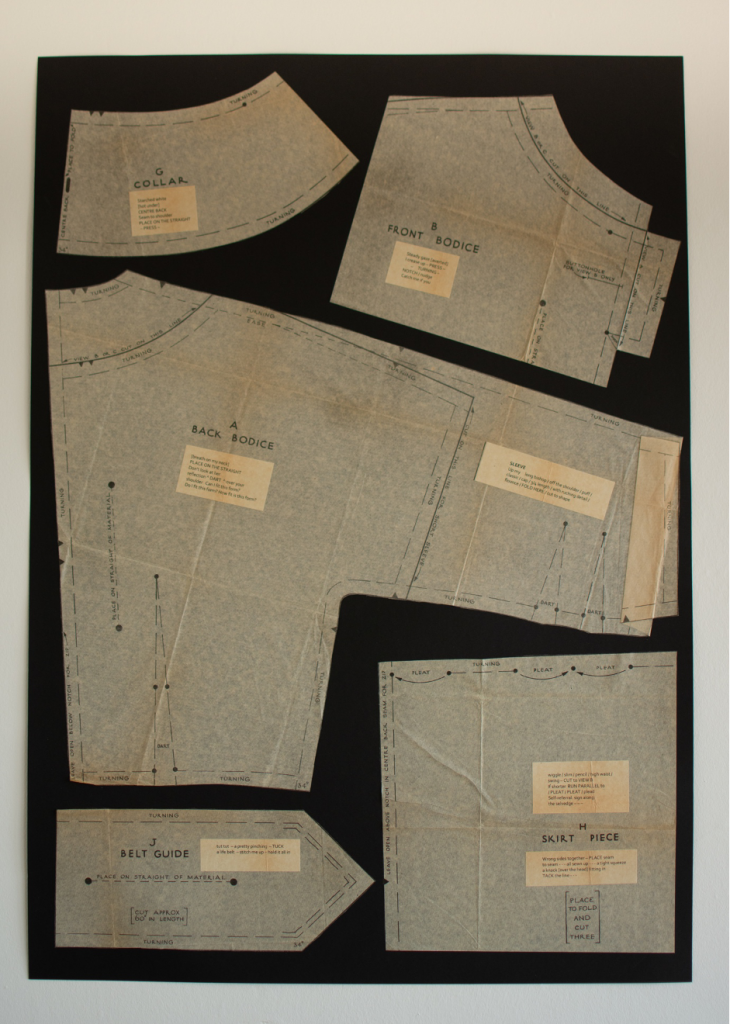
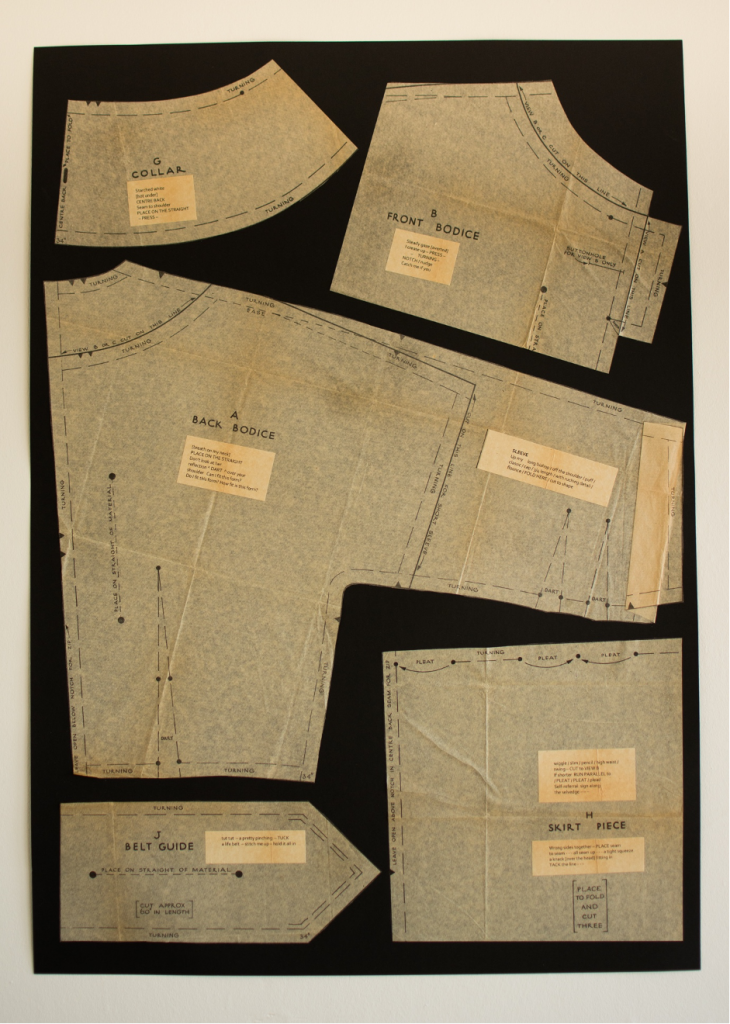
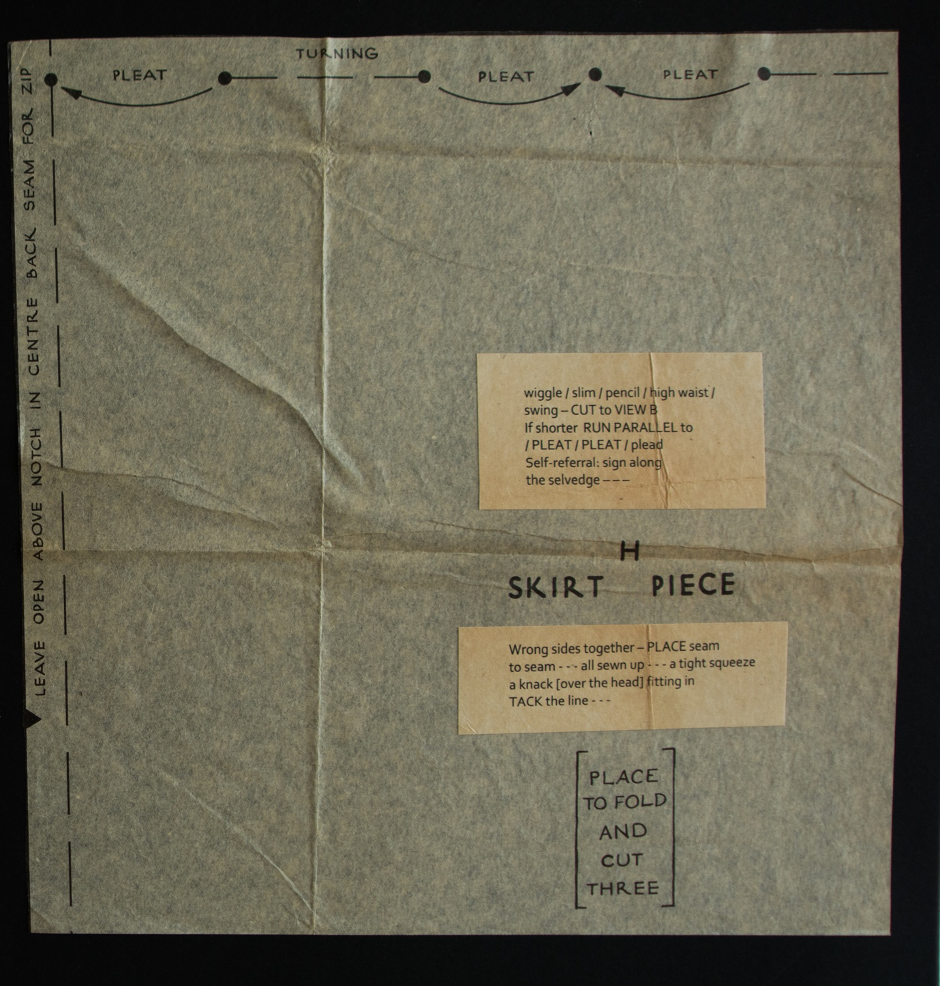
Printed pattern guide
Collar
Starched white[hot under]
CENTRE BACK
Seam to shoulder
PLACE ON THE STRAIGHT
– PRESS –
Front bodice
Steady gaze [averted]
I crease up – PRESS –
– TURNING –
NOTCH / nudge
Catch me if you
Back bodice[breath on my neck]
PLACE ON THE STRAIGHT
Don’t look at her
reflection ^ DART ^ over your
shoulder Can I fit this form?
Do I fit this form? How fit is this form?
Sleeve
Up my long bishop / off the shoulder / puff /
classic / cap / 3/4 length / with ruching detail /
flounce / FOLD HERE / cut to shape
Skirt piece front
wiggle / slim / pencil / high waist /
swing – CUT to VIEW B
If shorter RUN PARALLEL to
/ PLEAT / PLEAT / plead
Self-referral: sign along
the selvedge – – –
Skirt piece back
Wrong sides together – PLACE seam
to seam – – – all sewn up – – – a tight squeeze
a knack [over the head] fitting in
TACK the line – – –
Belt
tut tut – a pretty pinching – TUCK
a life belt – stitch me up – hold it all in
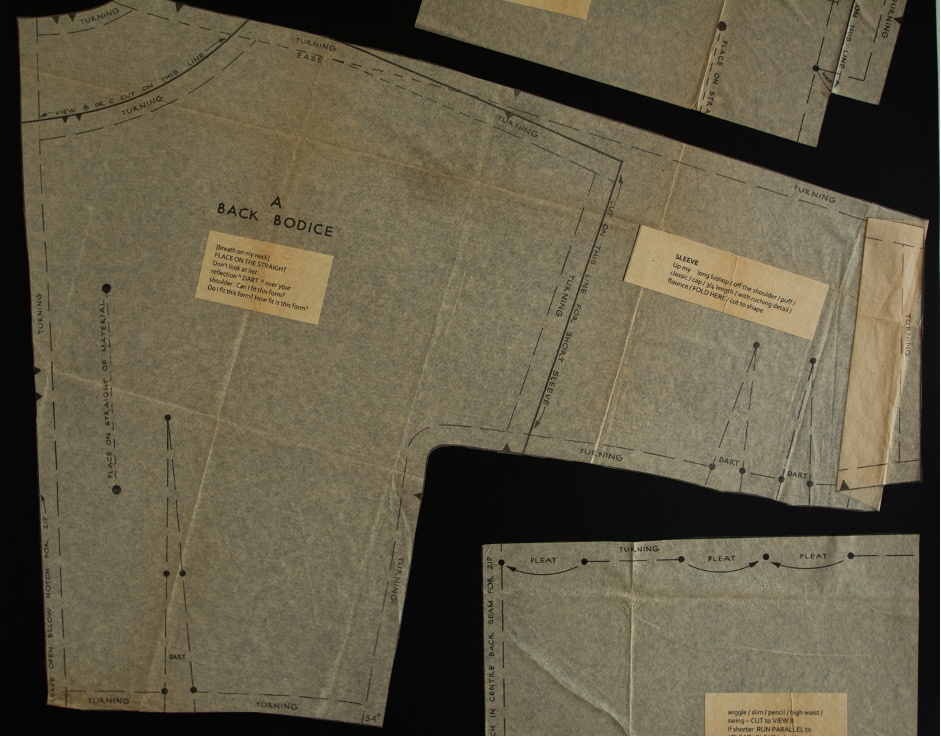
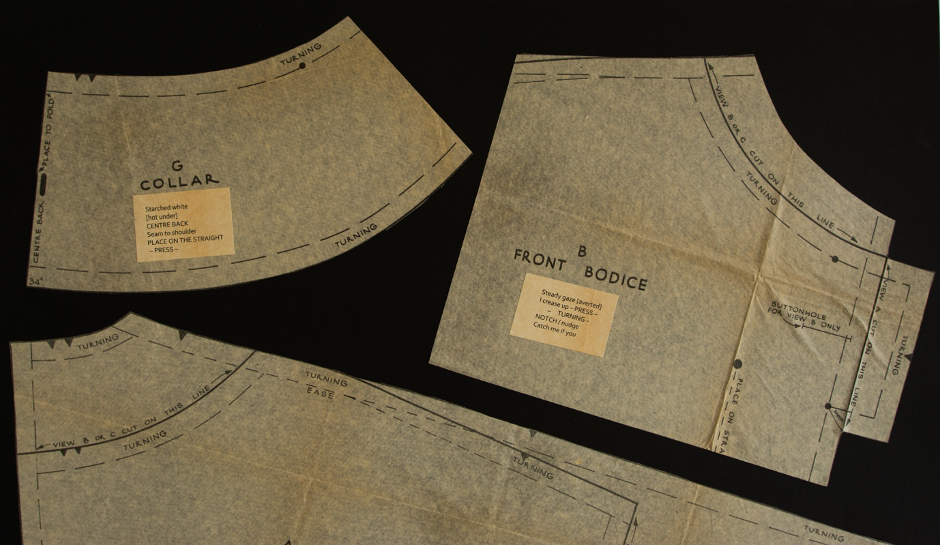
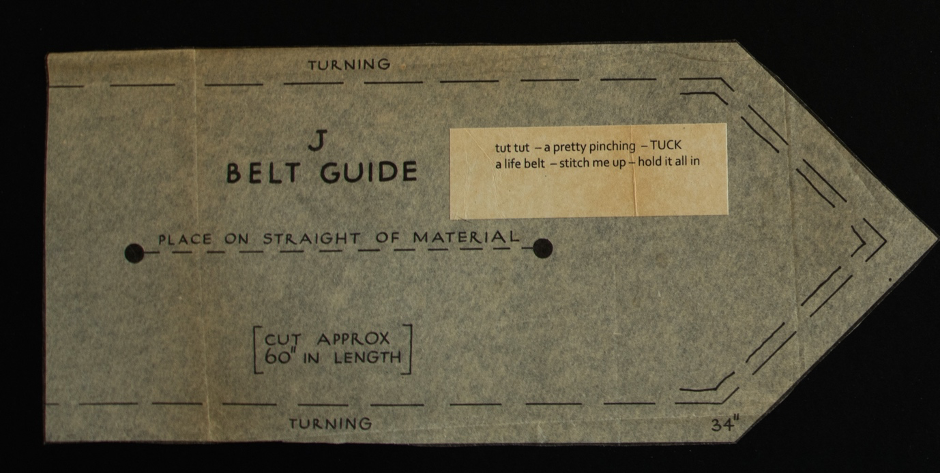
Version 1
I make you sick
You make me sick
– touché
So you prescribe
an emetic
to purge any
unwanted thoughts
I may have,
to avert my longing
I am violently at sea
Every woman a wave
I can’t look
at the female form
for three months
can’t pass a mirror for fear
of meeting
my own eye
Then the effects
subside
I sense a high tide mark
at certain times, but
remain unchanged
I raise my gaze
Define
deviation
Version 2
They say: anticipation is worse than
I am waiting to receive an image upside down
from ganglion cells via (don’t shoot the messenger)
optic nerves to deviant cerebral cortex
traitorous brainstem
They say: anticipation is
the flinch before
a piloerection response
a wave of resistance
knows me better than myself
They say: I can avert my gaze from curves
of marble breasts seductive glances over
cold shoulders
They say: choose instead the fuzz below
a man’s navel. I say: choose to reject the lurch
in the stomach that precedes the sudden grip
of my wrists the shredding of nerves
I say: ironic
that they introduced me to soft porn
They say: voluntary and consenting
I say: rock and a hard place
They say: the chance of uncovering
latent heterosexuality
I say: Surprise! When I learn later
that I was successfully cured, I turn
to tell my same-sex partner of twenty years
I still remember smirking psychologists
an examination (which I didn’t question) and
the [non]sense that they were beyond reproach
What they said: is written up in a scientific journal
What I say: is a version of me is living a lie
in an archive
Commentary
In 1965 The World Health Organisation’s International Classification of Diseases (ICD-8) added Lesbianism and sodomy to the collection of sexual deviances, which already contained ‘homosexuality’. It wasn’t until 1992 that ‘homosexuality’ finally disappeared from ICD-10, stating that there was ‘a lack of empirical evidence supporting the pathologisation and medicalisation of variation in sexual orientation and expression’. In 1992 ‘gender identify disorder’ made its first appearance in ICD-10. *
Aversion therapy was a ‘treatment’ that became popular in the 1960s and into the early seventies. The ‘treatment’ – which took the form of emetic drugs or electric shocks – was given while exposing a patient to sexual images of women or men with the intention of repelling ‘homosexual attraction’.
When I read about queerness as a diagnosis, about aversion therapy as ‘treatment’, it resonated not least with my queer self, but also with present day politics. Personally I feel that although attitudes have progressed a long way from the 60’s, and many LGBT+ rights have been won along the way, we are now at a standstill. For example: a promise by the UK Government to ban conversion therapy four years ago has not yet been actioned, in fact was briefly rescinded, then promised again but with the exclusion of trans people; not so far away in Central and Eastern European some countries are passing regressive laws, fuelling an increasing hostile environment for LGBT+ individuals.
I started this project with a black & white image from the Gartnavel archive. It shows two men standing in front of a dolls’ house. The men have their backs to us, they are wearing suits, they are not unidentifiable, presumably they are patients who have constructed the dolls’ house. The house is an empty shell. Who will fill it? Perhaps the women will decorate it, furnish it, care for it. The staff overseeing the activity are in white coats, a man looking at the camera is caught mid- expression, in action. The woman appears passive, her gaze directed away from camera, downward, she looks pristine, like a doll. It seems to embody the gendered values of domesticity at the time.
This was an early example of occupational therapy (OT), the practice of using activity therapeutically, to maintain or regain independence and function. I am an occupational therapist. The practice, now an accredited health profession, has moved on from craft and activities of distraction, but the core principles remain the same: that engaging in activity is good for human wellbeing.
A hundred years ago David K Henderson – the newly appointed superintendent physician of Gartnavel Royal – declared that the hospital had employed the first instructor in occupational therapy in Scotland. Dorothea Robertson – a pioneer of a profession that was as yet unaccredited in Britain – took up post in 1923. It had been recognised that although the ‘aided patients’ were occupied with domestic, manual and physical activities, there had long been a need for occupations for the ‘private patients’, especially the women. There was a class divide, and an instructor was employed for the growing number of middle-class women seeking treatment for their mental health; those activities were centred on craft and homemaking skills. **
When returning to the image of the dolls’ house, I saw that it could represent many things within its template of rooms, its stages. We project ourselves, our ideas of the world, onto a dolls’ house. It is a world we are in control of, we can make the rules, and subvert them. But within a formal setting, under someone else’s gaze, it is a performance space where a microcosm of cultural and societal norms and expectations come into play. In an institutional setting the patient is always being observed, is performing, or seen to be performing.
As I read around the history of Occupational Therapy in Scotland, I considered the craft-based occupations of the 50’s and 60’s. It was a time when homemaking was highly valued, and the roles in the home were strictly gendered, weighted with expectations of conformity. The concept of homemaking seemed to me to be embodied in the sewing patterns popular at the time.
Although I am an Occupational Therapist by profession, and a poet by compulsion, my first training was as an artist. I have always enjoyed creating with word and image, and in this project the ideas evolved through visual exploration as well as through writing. The dolls’ house rooms became boxes, constraints, spaces to be fitted into, conforming to traditions and expectations, behaviours acted out according to codes and rules that followed prescribed and gendered patterns. Eventually I sourced some sewing patterns from the era, which seemed to incorporate all these ideas.
Records of aversion therapy are limited, and most are written about the male experience, male homosexuality being criminalised at the time and therapy sometimes offered as an alternative to prison. It could be prescribed, or patients could self-refer, these ‘volunteers’ no doubt under enormous religious or societal pressure. Women seemed absent from much of the records, despite female homosexuality still being classified as a mental disorder that could be treated, Professor Helen Sandler and Dr Sarah Carr chose to try and uncover lesbian and bisexual women’s experiences of psychiatric treatment: Hidden from history? A brief modern history of the psychiatric “treatment” of lesbians and bisexual women in England. *** My Version poems in this project are based on their research, which I found via The Welcome Collection website.
Carr and Sandler’s research compelled me to respond to it. Although there appears to be no records of aversion therapy being carried out at Gartnavel Royal, this doesn’t mean it didn’t happen here; there are always gaps in an archive, people missed, stories untold. This is where the project has reached so far. There is so much more to explore. I think artistic responses can convey something real, tangible and human from the distances contained within an archive, to bring it up close and personal, to resonate with us today. I would really like to further develop the ideas I’ve started to make work about, around sexuality and gender roles, around occupational therapy, prescription and treatment, and conformity, with pattern and form, through word and image.
*Sexual Diversity and UK Psychiatry and Mental Health, from ‘Mind, State and Society: Social History of Psychiatry and Mental Health 1960-2010 published by Royal College of Psychiatrists, (2021) Open access: www.cambridge.orgHidden from history?
** Opportunities Not prescriptions: The Development of Occupational Therapy in Scotland 1900-2009, Catherine F. Paterson, Aberdeen History of Medicine Publication No. 3 (2010)
*** Hidden from history? A brief modern history of the psychiatric “treatment” of lesbian and bisexual women in England Sarah Carr, Helen Sandler The Lancet (11/02/2019)
https://www.thelancet.com/journals/lanpsy/article/PIIS2215-0366(19)30059-8/fulltext
[Photographs of Occupational Therapy at Gartnavel, HB13/15/145]
Vicki Husband’s first collection of poetry, This Far Back Everything Shimmers, was shortlisted for the Saltire Society Scottish Poetry Book of the Year 2016. Sykkel Saga, a pamphlet-long poem, was published by Mariscat Press in 2019. Vicki’s poetry has been widely published, anthologised, broadcast on radio, and translated as part of collaborative projects with poets from Pakistan and Ukraine. Vicki studied fine art as her first degree and more recent work has explored visual poetics; a triptych of ‘rooms’ were exhibited in ‘Off-page’ a visual-poetry exhibition in 2023. Vicki qualified as an Occupational Therapist in 1999 and has worked for the NHS in community rehabilitation for almost 20 years. Vicki lives and works in Glasgow and her current writing explores the city and its people and its health.
